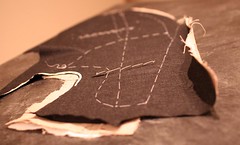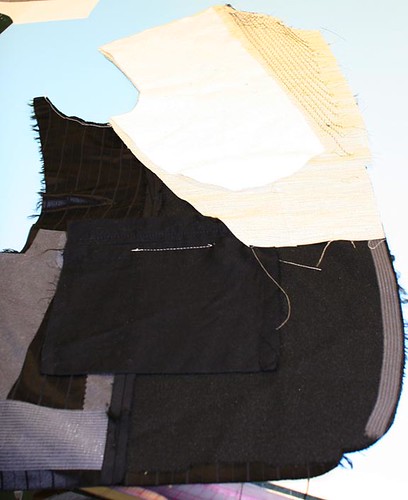
We hear the terms `pad stitching` and `padded lapels` frequently but not everybody understands the significance.
One of the important principles of tailoring, and which distinguishes tailoring from ordinary `flat`sewing, has to do with the fact that concentric arcs or circles become longer as they radiate from the centre. In easier terms, picture the starting line of a circular race track- the starting point of each lane is in a different spot because the outer lanes are longer than the inner lanes as they go around a bend. Tailored clothing consists of many layers of fabric that bend around each other in order to create shape. The layers of fabric and canvas in a lapel, for example, are like the lanes of a race track; the outer ones are necessarily longer than the outer ones; unlike a race track, whose lanes are staggered to maintain a consistent length, the tailor will cut the layers of fabric to different lengths so that when bent into shape they all meet together at the seam.
We have seen in a previous post that canvas contains horse hair which gives it a lofty roll. This roll contributes to the roll of the lapel but is not solely responsible for it. Once the tailor has basted the canvas and the cloth together, he will roll the lapel over his hand; the canvas being the 'outer lane' of the race track is thus a little longer than the 'inner lane' of fabric. He will sew a row of pad stitches parallel to the roll line, just catching the cloth underneath so the stitch is not visible under the lapel. At the end of the row he will roll the lapel over his hand again and sew another row of stitches, and continue until the whole lapel has been done. When it is finished, the canvas and cloth now roll as one; the canvas lends loft to the roll, but the additional length of canvas has been stitched permanently in place and so the two want to maintain the shape they were given. Notice in the photo above that the lapel stays curled- it does not fall flat to the table as it would have done had it not been pad stitched. Not only does this pad stitching create a beautiful roll in the lapel, a sign of a good-quality garment, but also helps the lapel to hug the chest tightly and not pull away, another indicator of quality.
Machines now exist which can do this job automatically, using special sensors so that the machine knows when it has reached the end of the lapel, and it will return to its starting point, advance a row, and sew the next one. The machines are quite fabulous, but also fabulously expensive; a pair (one for the right, one for the left) can cost upwards of $80,000 so are within the reach of mass-producers only. The machine takes only a few minutes to do a garment, and can do the two sides simultaneously. The garment shown above has a wide, peak lapel and took me about half an hour per lapel to do. This is a photo of a pad-stitch machine.
This is a half-canvas garment which has been pad stitched by machine
This is the same garment, showing the degree of roll.
The machine stitch is very consistent, however I may want to roll certain parts of a lapel a little more tighly, such as the very tip of a peak lapel, which can not be done by machine but can easily be done by hand. You will notice that the garment which has been stitched my machine does not roll as much as the garment at the top of the page, which was paddded by hand. This does not mean that it will not roll as well; the canvas will still provide a great deal of loft to the roll. It may not, however, hug the chest quite as tightly as a hand-padded lapel will. By varying the amount of canvas worked over the cloth and by stitching closer together or further apart I can vary the degree of roll in the lapel. This is a very fine point and I am not sure that it makes a very great difference in a finished, pressed garment. My unsubstantiated opinion is that it is better done by hand, but to really investigate further I would have to make two identical suits using identical trims and machine pad one of them, and do the other by hand. Maybe when I have retired and have nothing better to do.
The same principles apply when making the canvas front- on the CANVAS page you see a full front which has been pad stitched by hand. Again, there are several layers of material which have been worked into a particular shape and stitched together so that they will hold this shape. As I stated on that page, while I enjoy making my own fronts, I do not think there are any substantial benefits to doing them by hand over doing them by machine. I have done both ways for a long time; one is generally hoping for softness in the chest rather than stiffness and the machine does an admirable job. The amount of shaping and density of stitching can be controlled by the operator, unlike when machine-padding the lapels so I think it really is a toss-up on this issue.
It is important to note that if one were to press the lapel or chest flat you would lose almost all of the shaping which is why we generally advise against having things pressed by dry cleaners who may not be trained in pressing tailored garments (an art and a post unto itself).
So to recap, pad stitching is used to hold several layers of fabric together permanenlty in a particular shape. It gives the chest its shape, and gives the lapel its roll, helping to prevent it from pulling away from the chest- a fused lapel will never roll like a padded lapel and makes judging a garment`s quality easier. While I think it is a little better to pad a lapel by hand, I have seen no real proof of it in a finished garment; this is a matter of great contention and I do not pretend to have the answer.








6 comments:
Great read and very informative.
Thanks!!
I'm studying sewing and couldn't understand this bit.
Thank you
hi! what thread should I use for pad stitching? can i just use an ordinary thread instead of silk thread? where can i find the best silk thread for tailoring?
thank you
You can use regular thread if you wish, but my thread of choice for hand sewing is waxed skein silk, which most tailor supply houses carry. Guterman's R402E is a good choice, or this product
http://bergentailorsupply.com/silkhandskeinssizea.aspx
J
Hello JEFFERY Diduch!
I have read your posts and the Cutter and Tailor and these have been very important to me. Here in Brazil, has virtually no schools tailoring. There is a school run by the Association of Tailors, but is very weak so I realized through my research. I studied fashion in Senai, a large institution and about 200 hours of tailoring. But with the information collected on its website and in the other aforementioned books and was able to make the jackets men and women. I would send pictures to you or to Cutter and Tailor for you to evaluate my work. I am planning to do a course in Australia or London Tailoring in Saint Martin de Couture.
Marie Amorim
Thank you this was very informative! Do you travel and give lessons on the subject of tailoring? I am located in Canada and have been teaching this wonderful art myself. There is such a shortage of qualified people to carry forth this trade that it's a shame. Anyway I'm glad I happened to see this post I will look for more in the future. thank you for caring!
Maria Calautti founder of Le Grand Chic Italia School of Fashion in Canada.
Post a Comment